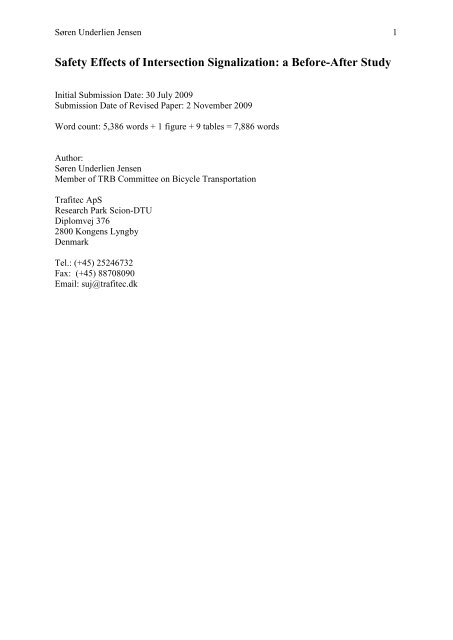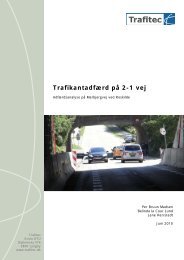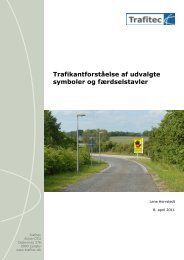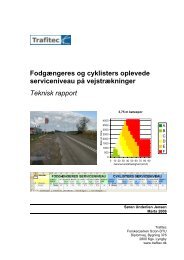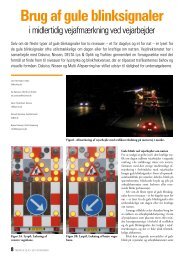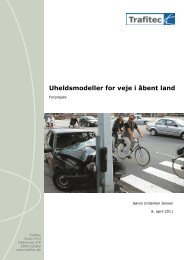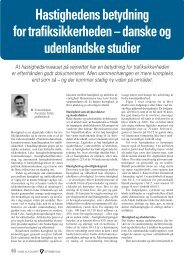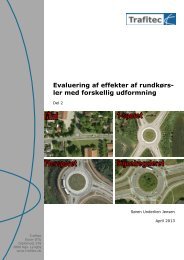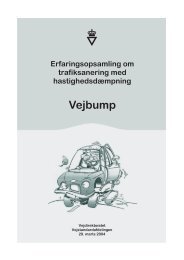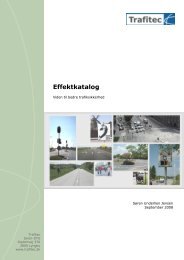Safety Effects of Intersection Signalization: a Before-After Study
Safety Effects of Intersection Signalization: a Before-After Study
Safety Effects of Intersection Signalization: a Before-After Study
Create successful ePaper yourself
Turn your PDF publications into a flip-book with our unique Google optimized e-Paper software.
Søren Underlien Jensen 1<strong>Safety</strong> <strong>Effects</strong> <strong>of</strong> <strong>Intersection</strong> <strong>Signalization</strong>: a <strong>Before</strong>-<strong>After</strong> <strong>Study</strong>Initial Submission Date: 30 July 2009Submission Date <strong>of</strong> Revised Paper: 2 November 2009Word count: 5,386 words + 1 figure + 9 tables = 7,886 wordsAuthor:Søren Underlien JensenMember <strong>of</strong> TRB Committee on Bicycle TransportationTrafitec ApSResearch Park Scion-DTUDiplomvej 3762800 Kongens LyngbyDenmarkTel.: (+45) 25246732Fax: (+45) 88708090Email: suj@trafitec.dk
Søren Underlien Jensen 2ABSTRACTThis paper presents a before-after crash and injury study <strong>of</strong> intersection signalization in anurban area. Conversion from yield to signal control at 54 intersections in central Copenhagen,Denmark, is analyzed. Police recorded crashes, which occurred at converted intersections aswell as crashes up to 500 meters away on roadways leading up to converted intersections, areincluded in the study. The method used accounts for general crash and injury trends, changesin traffic volumes, and also regression-to-the-mean effects in the before period. The bestestimates for mean safety effects <strong>of</strong> intersection signalization are decreases in crashes andinjuries <strong>of</strong> respectively 21 and 17 percent at 3-armed intersections, and 39 and 33 percent at4-armed intersections. These findings are in line with previous studies. The safety benefits atconverted intersections are primarily due to significant reductions in right-angle crashes.<strong>Safety</strong> is also improved on roadways up to 100 meters away from the center <strong>of</strong> the converted3-armed intersections, and up to 200 meters away from converted 4-armed intersections.About 60 percent <strong>of</strong> the total safety improvement occurred on the roadways and only about40 percent occurred at the converted intersections. In total, for converted intersections androadways up to 200 meters away, the best estimates for mean safety effects <strong>of</strong> intersectionsignalization are decreases in crashes and injuries <strong>of</strong> respectively 19 and 21 percent near andat the 3-armed intersections, and 26 and 33 percent near and at the 4-armed intersections.
Søren Underlien Jensen 3INTRODUCTION<strong>Intersection</strong>s are <strong>of</strong>ten signalized in urban areas in order to improve traffic operations, safety,perceived risk and signal coordination.Many safety studies <strong>of</strong> intersection signalization have been undertaken worldwide. Ameta-analysis <strong>of</strong> 28 studies published in 1967-1995 shows that signalization <strong>of</strong> 3-armedintersections reduces injury and property damage only (PDO) crashes by 15 percent, andsignalization <strong>of</strong> 4-armed intersections reduces injury crashes by 30 percent and PDO crashesby 35 percent (1). A more recent North American study <strong>of</strong> signalization <strong>of</strong> 22 three-armedand 100 four-armed intersections in urban areas found that the number <strong>of</strong> injury crashes fellby 14 percent at 3-armed intersections and 23 percent at 4-armed intersections (2). A newAmerican study <strong>of</strong> signalization <strong>of</strong> 6 three-armed and 39 four-armed intersections in ruralareas found a reduction in crashes by 44 percent (3). Many studies state that intersectionsignalization reduce the number <strong>of</strong> right-angle crashes, whereas the number rear-end crashesincreases, e.g. the recent American studies found reductions in right-angle crashes <strong>of</strong> 34-77percent and a 38-58 percent increase in rear-end crashes (1-3). These effects are based onchanges in the number <strong>of</strong> crashes at intersections or intersection-related crashes. It is unclearin many studies how far away from the intersection center an intersection-related crash mayoccur. It is also relatively unclear in these studies how intersections and signal-control weredesigned before and after the conversion. The recent American studies include intersectionsbeing converted from stop to signal control.The before-after study, which is presented in the following, focus on safety effects <strong>of</strong>signalization <strong>of</strong> 54 intersections in central parts <strong>of</strong> Copenhagen, Denmark. The intersectionswere signalized in 1977-1999. The study includes one 5-armed, 35 four-armed and 18 threearmedintersections. <strong>Intersection</strong>s were converted from yield (shark teeth) to signal control.Channelization was rare on minor roads both before and after conversion, but <strong>of</strong>ten presenton major roads especially after conversion. <strong>Intersection</strong>s were illuminated by street lightingboth before and after conversion. All traffic signals operate pre-timed. There is typically 2-4signal heads for through vehicular traffic for each direction with 1-3 signal heads placed onpoles on the near side, 0-1 signal heads on span-wire close to intersection center and 1-3signal heads on poles on the far side. Flashing yellow and right-turn on red is not allowed.Almost all signalized arms have pedestrian signals and zebra crossings.The main purpose <strong>of</strong> the study is to identify safety effects <strong>of</strong> signalization both atconverted intersections and roadways leading up to converted intersections. Police recordedcrashes, which occurred at converted intersections as well as crashes on the roadways up to500 meters (1,639 feet or 0.31 miles) away from the center <strong>of</strong> the converted intersection, areincluded in the study. Some <strong>of</strong> the studied roadways are shorter than 500 meters, because theroadway ends or traffic on the roadway faces a yield sign or signal-control. The studiedroadways therefore sometimes end at existing signalized intersections, roundabouts or otheryield controlled intersection (hereafter called end-crossroads), which are located less than 500meters away from the converted intersection.Crashes are split into crashes at converted intersections and crashes on roadways byusing crash information. Police <strong>of</strong>ficers and crash records technicians judge whether or notthe crash is intersection-related, and this judgment is used to make the split. Roadway crashesare split into whether they occurred on the road, which was respectively minor or major priorto signalization. Roadway crashes are also split into crashes on links and crashes at endcrossroads.The different locations <strong>of</strong> crashes are explained in Figure 1.
Søren Underlien Jensen 4FIGURE 1 Explanation <strong>of</strong> Location <strong>of</strong> Crashes at Converted <strong>Intersection</strong> (red box) andRoadways. Roadways are split into Main Roads (blue line) and Minor Roads (greenline) and also Links (red line) and End-crossroads (blue box).Existing signalized intersectionConverted intersectionRoundaboutYield sign on studiedroad at T-junctionMETHODOLOGYA stepwise methodology is used. First, a general comparison group is used to account forcrash trends. Second, changes in traffic volumes are taken into account. And third, ananalysis <strong>of</strong> long-term crash trends is made in order to check for abnormally high or low crashcounts, i.e. regression-to-the-mean, in the before period. It was chosen to use equally longbefore and after periods, which for the individual studied intersections and roadways was <strong>of</strong>1-5 years duration. The expected number <strong>of</strong> crashes in the after period is calculated based ona formula, here shown in the general form:( 1) AExpected= A<strong>Before</strong>⋅ CTrend⋅ CTraffic⋅ CRTM,where A Expected is the number <strong>of</strong> crashes or injuries expected to occur in the after period ifintersections were not signalized, A <strong>Before</strong> is the number <strong>of</strong> crashes or injuries that occurred inthe before period, C Trend , C Traffic and C RTM are correction factors for crash trends, trafficvolumes and regression-to-the-mean respectively.The study is part <strong>of</strong> project including studies <strong>of</strong> reconstructions, markings, signalcontroland traffic calming schemes in the City <strong>of</strong> Copenhagen. A major effort was made inorder to register all physical changes to the road network in the period 1976-2004. Severalhundred schemes were identified.Several intersections and roadways had undergone more than one reconstruction orother scheme. Only “clean” schemes are studied, meaning that for the intersections beingsignalized and the roadways leading up to these intersections, no other scheme has beenimplemented in before and after periods and in the year when signals was installed.
Søren Underlien Jensen 5Unchanged roads with known developments in traffic volumes were used to set up ageneral comparison group. The Copenhagen Police District covers the entire area <strong>of</strong> the City<strong>of</strong> Copenhagen, and there is no indication that crashes are registered differently in one cityquarter compared to another. The general comparison group consists <strong>of</strong> 110 km <strong>of</strong> roads bothintersections and links between intersections, with 170 locations, where motor vehicle andbicycle / moped traffic is counted yearly or every fourth to sixth year. A total <strong>of</strong> 24,369crashes and 8,648 injuries occurred on the 110 km <strong>of</strong> roads in the period 1976-2004.Since a general comparison group has been chosen instead <strong>of</strong> a matched comparisongroup, an effort was made in order to avoid consequences <strong>of</strong> larger differences between thegeneral comparison group and the studied intersections and roadways. Trends for differenttypes <strong>of</strong> crashes and injuries <strong>of</strong> the general comparison group were compared. Crash trendsfor different types <strong>of</strong> intersections and links are very similar, hence no need for sub-grouping.However, trends for different crash or injury severities and transport modes exhibit ratherdifferent developments. It is reasonable to describe trends by 7 crash sub-comparison groupsand 5 injury sub-comparison groups. These sub-groups are defined in Table 1.TABLE 1 Definition <strong>of</strong> 12 Sub-comparison Groups (in Brackets: Number <strong>of</strong> Crashes orInjuries 1976-2004)a Bicycle / mopedb Pedestrianc Motor vehicleCrashes with killed / severe injuries 1 (2,197) 2 (1,445) 3 (1,584)Crashes with minor injuries and no killed /severe injuries4 (1,289) 5 (1,228)Property damage only crashes 6 (3,316) 7 (13,310)Killed and severe injuries 8 (2,235) 9 (1,477) 10 (1,907)Minor injuries 11 (1,359) 12 (1,670)a Crashes involving cyclists / moped riders and injuries in these crashes,b Crashes between pedestrians and motor vehicles and injuries in these crashes,c Crashes only with motor vehicles involved and injuries in these crashes.So the correction factor C Trend is actually 12 different correction factors, which is thenumber <strong>of</strong> crashes or injuries in the sub-comparison group in the after period divided by thenumber <strong>of</strong> crashes or injuries in the sub-comparison group in the before period. Theindividual correction factor, e.g. C Trend,1 , is then multiplied with the same sub-group <strong>of</strong>crashes, which occurred at the studied intersection and roadways in the before period,A <strong>Before</strong>,1 , as part <strong>of</strong> Formula 1. C Trend is only a two-point trend, where crashes in all years inthe before period are summed and crashes in all years in the after period are summed. Due tothis a yearly safety effect, e.g. safety effect in the first, second, … year after implementation,is not possible to describe.The correction factor C Traffic is based on changes in traffic volumes at the studiedintersections and roadways and in the general comparison group. The relationship betweentraffic flow and crashes or injuries is non-linear. Danish crash prediction models for links(Formula 2) and intersections (Formula 3) are most <strong>of</strong>ten <strong>of</strong> the following kinds:(2)(3)E(µ ) = α ⋅ NE(µ ) = α ⋅ Nβ,β1⋅ priNβ2sec,
Søren Underlien Jensen 6where E(μ) is the predicted number <strong>of</strong> crashes or injuries, N is annual average daily traffic(AADT) on the link, N pri and N sec are the incoming motor vehicle daily traffic from primaryand secondary directions at intersections, and α, β, β 1 and β 2 are estimated parameters. β is<strong>of</strong>ten close to 0.7, and β 1 and β 2 are <strong>of</strong>ten close to 0.5 in the many models for urban roads,which have been developed during the last decades in Denmark, whereas α varies betweenthe different types <strong>of</strong> roads and intersections (4-11). Figures for α varies, because the level <strong>of</strong>safety depends on the type <strong>of</strong> road and intersection. In this case, bicycle / moped traffic isalso known, and here the sparse number <strong>of</strong> crash prediction models indicate that bicycle /moped traffic only influence the number <strong>of</strong> crashes involving cyclists and moped riders.Formula 2 and 3 are then used to set up formulas for C Traffic :(4)CTraffic, pmv,link⎛ MV⎜⎜ MV= ⎜ MV⎜⎝MVafterbeforeCG,afterCG,before⎞⎟⎟⎟⎟⎠0.7,(5)CTraffic,bike,link⎛ MV⎜⎜ MV= ⎜ MV⎜⎝MVafterbeforeCG,afterCG,before⎞⎟⎟⎟⎟⎠0.7⎛ BM⎜⎜ BM⋅ ⎜ BM⎜⎝BMafterbeforeCG,afterCG,before⎞⎟⎟⎟⎟⎠0.7,(6)CTraffic, pmv,intersection⎛ MV⎜⎜ MV= ⎜ MV⎜⎝MVpri,afterpri,beforeCG,afterCG,before⎞⎟⎟⎟⎟⎠0.5⎛ MV⎜⎜ MV⋅ ⎜ MV⎜⎝MVsec, aftersec, beforeCG,afterCG,before⎞⎟⎟⎟⎟⎠0.5,(7)CTraffic,bike,intersection⎛ MV⎜⎜ MV= ⎜ MV⎜⎝ MVpri,afterpri,beforeCG,afterCG,before⎞⎟⎟⎟⎟⎠0.5⎛ MV⎜⎜ MV⋅ ⎜ MV⎜⎝ MVsec, aftersec, beforeCG,afterCG,before⎞⎟⎟⎟⎟⎠0.5⎛ BM⎜⎜ BM⋅ ⎜ BM⎜⎝ BMpri,afterpri,beforeCG,afterCG,before⎞⎟⎟⎟⎟⎠0.5⎛ BM⎜⎜ BM⋅ ⎜ BM⎜⎝ BMsec, aftersec, beforeCG,afterCG,before⎞⎟⎟⎟⎟⎠0.5,where C Traffic, pmv is the traffic correction factor for pedestrian and motor vehicle crashes orinjuries (see Table 1), C Traffic, bike is the traffic correction factor for bicycle-moped crashes orinjuries, MV, MV pri and MV sec are AADT and incoming motor vehicle daily traffic at thestudied intersections and roadways on link, primary and secondary direction respectively,BM, BM pri and BM sec are bicycle-moped daily traffic at the studied intersections androadways on link, primary and secondary direction respectively, and MV CG and BM CG aremotor vehicle traffic and bicycle / moped traffic in the comparison group respectively.
Søren Underlien Jensen 7Traffic data from before and after periods are used, hence, increases and decreases intraffic volumes from before to after are accounted for. Traffic volumes from the comparisongroup is included in formula 4-7 in order to avoid “double accounting” for the general changein traffic volumes, since this is already accounted for once in C Trend . Changes in trafficvolumes are known for 43 <strong>of</strong> the 54 study sites. The change from before to after in motorvehicle traffic at the studied intersections and roadways varied from -19 percent to +65percent, however, most changes were small and followed the changes in the generalcomparison group. C Traffic, pmv is on average 1.019. Similar, the change in bicycle-mopedtraffic was between -29 percent and +115 percent, but again most changes followed thegeneral comparison group. C Traffic, bike is on average 1.034. Where changes in traffic volumesare unknown C Traffic has been set to 1, i.e. changes in traffic on the study site follows changesin traffic in the general comparison group.The analysis <strong>of</strong> long-term crash trends is made in order to check for abnormally highcrash or injury counts, i.e. regression-to-the-mean, in the before period. The analysis is madeusing a before-before period, which is a 5-year period 8 to 12 years before signalization. Thebefore-before period is chosen because it is prior to an eventual black spot identificationperiod or other type <strong>of</strong> systematic crash investigation period that may have lead tosignalization. This before-before period is then used to calculate an expected number <strong>of</strong>crashes and injuries in the before period <strong>of</strong> the studied intersections and roadways by makingcorrections for general crash trends and traffic volumes:AExpected , <strong>Before</strong> = A<strong>Before</strong>−<strong>Before</strong>⋅ CTrend⋅ CTrafficThe C RTM correction factor is then calculated as the expected number <strong>of</strong> crashes in the beforeperiod divided by the observed number <strong>of</strong> crashes in the before period, and likewise forinjuries. However, because not all treated roads can undergo this type <strong>of</strong> analysis, the C RTM isset to be the same for all studied intersections and roadways.Only for 20 <strong>of</strong> 54 study sites it is possible to make the calculation <strong>of</strong> C RTM , becausecrash records only are available back to 1976 or other schemes were implemented at thestudied intersections and roadways 6-12 years before signalization.TABLE 2 Expected and Observed Crashes and Injuries in the <strong>Before</strong>-before and<strong>Before</strong> Period respectively for Studied <strong>Intersection</strong>s and RoadwaysObserved Expected Observed Change in safety (percent)BEFORE-BEFORE BEFORE BEFORE Best estimatea 95% CI<strong>Intersection</strong>s All crashes 128 189 200b +17b -17 ; +65All injuries 55 57 76 +31 -10 ; +91Roadways All crashes 905 1,014 994 -1 -10 ; +9All injuries 446 332 334b +1b -20 ; +27a 95% confidence interval, b heterogeneous, i.e. results <strong>of</strong> random effects model.The results <strong>of</strong> the analyses <strong>of</strong> long-term crash trends are shown in Table 2. Metaanalyseshave been used to calculate best estimates for safety changes and related confidenceintervals. Table 2 shows no statistically significant changes. However, the number <strong>of</strong> injuries(and injury crashes) at the intersections is much higher than expected, actually 31 percenthigher than expected. The correction factor, C RTM , is therefore set to 1 / 1.31 = 0.76 for
Søren Underlien Jensen 8injuries and injury crashes at the intersections. Analyses indicate that the correction factorshould rely on the severity <strong>of</strong> injury, but the numbers <strong>of</strong> respectively killed, severe injury andslight injury are relatively small, and it is not reasonable to create different correction factorsfor the different injury severity levels. Instead only changes in all injuries are shown in theresults. Detailed analyses <strong>of</strong> potential regression-to-the-mean effects on the roadways showthat the crash trends follow the trends in the general comparison group at any distance (10-500 meters away) from the intersection being signalized. For PDO crashes at the intersectionsand for both crashes and injuries on the roadways, C RTM is set to 1, because the observednumber <strong>of</strong> crashes and injuries in the before period is only respectively 0.6 percent higher,1.0 percent lower and 0.5 percent higher than expected, i.e. the trends in these crashes andinjuries follows almost perfectly the trends in the general comparison group. The resultsabout the regression-to-the-mean effects fit well with statements from the city administration.They state that they convert from yield to signal control when many injury crashes or severeinjury crashes occur at the intersection. In other words, the decision to install signals is notbased on the number <strong>of</strong> PDO crashes at the intersection or crashes on roadways.There are major differences in correction factors between study sites primarily due togeneral crash trends being different during the period 1976-2004. Due to the long analyticalperiod, meta-analysis rather than simple sums <strong>of</strong> crashes and injuries is used in order todescribe best estimates for mean safety effects and the variance <strong>of</strong> these effects. The metaanalysismethodology is described by Elvik (12-13). Below is a short description <strong>of</strong> the logodds method <strong>of</strong> meta-analysis applied in this study.Each estimate <strong>of</strong> safety effect at an intersection or a roadway or alike was assigned astatistical weight inversely proportional to its variance. The variance <strong>of</strong> the logarithm <strong>of</strong> theodds ratio is:vv ii = 1 AA + 1 BB + 1 CC + 1 DD ,where A and B is the number <strong>of</strong> crashes at the studied site in respectively the before and afterperiod, and C and D is the number <strong>of</strong> crashes in the general comparison group in respectivelythe before and after period. The statistical weight <strong>of</strong> each estimate in the fixed effects model<strong>of</strong> meta-analysis is:ww ii = 1 vv iiThe weighted mean safety effect based on a set <strong>of</strong> estimates <strong>of</strong> safety effects is:yy = exp ∑∑ggii=1ggii=1ww iiww iiyy ii,where y i is the logarithm <strong>of</strong> each estimate <strong>of</strong> safety effect and w i is that statistical weight asdescribe above.The fixed effects model <strong>of</strong> meta-analysis is based on the assumption that there is onlyrandom variation in findings between safety effects at the studied sites. To test the validity <strong>of</strong>this assumption, the following test statistic, Q, is estimated:
Søren Underlien Jensen 9gg2QQ = ww ii yy ii − ∑ ggii=1 ww iiyy ii 2gg∑ii=1ii=1ww iiThis test statistic has a χ 2 distribution with g – 1 degrees <strong>of</strong> freedom, where g is the number <strong>of</strong>estimates <strong>of</strong> safety effect (number <strong>of</strong> studied sites) that have been combined. If this teststatistic is statistically significant, a random effects model <strong>of</strong> analysis will be adopted. In thismodel, the statistical weight assigned to each safety effect is modified to include a componentreflecting the systematic variation <strong>of</strong> estimated safety effects between studies sites. Thiscomponent is estimated as follows:σσ 2 [QQ − (gg − 1)]θθ = ,ccwhere Q is the test statistic described above, g is the number <strong>of</strong> estimates and c is thefollowing estimator:ggcc = ww iiii=1− ggww ii 2ii=1gg∑ii=1ww iiThe variance <strong>of</strong> each modified safety effect now becomes:vv ii ∗ = σσ θθ 2 + vv iiThe corresponding modified statistical weight becomes:ww ii ∗ = 1vv ii ∗A 95 percent confidence interval (95% CI) for the weighted mean estimate <strong>of</strong> safety effect isobtained according to the following expression:⎡95% CI = exp ⎢ ∑ gg⎢ ∑⎣ii=1ggii=1ww iiyy ii1 ± 1.96 ∙ww iigg∑ii=1ww iiThe weights <strong>of</strong> this expression are either the fixed effects weights <strong>of</strong> the random effects,depending on the model <strong>of</strong> analysis adopted. Fixed effects models are used for homogeneousmean effects (Q is not statistical significant), i.e. only random variation in estimated effects.Random effects models are used for heterogeneous mean effects (Q is statistical significanton a 5 percent level).When the number <strong>of</strong> crashes is zero at a studied site in the before or after period, i.e.when A or B is zero, then the log odds <strong>of</strong> meta-analysis does not work. The tradition in these⎤⎥⎥⎦
Søren Underlien Jensen 10situations is to add a half crash. In this study a half crash has been added number <strong>of</strong> crashes inthe before period, and a half crash multiplied by the correction factors C Trend, C Traffic and C RTMhas been added to respectively the number <strong>of</strong> expected crashes in the after period and thenumber <strong>of</strong> crashes in the after period. This works well when there are none or only few zerovalues. However, in this study the number <strong>of</strong> zero values are high, when crashes are split intodifferent types, e.g. rear-end and right-angle crashes. Therefore simple sums <strong>of</strong> crashesinstead <strong>of</strong> meta-analysis are used in order to estimate mean safety effects when crashes aresplit into different types.RESULTSThe results <strong>of</strong> the study, i.e. safety effects <strong>of</strong> intersection signalization, are given in threeparts respectively for converted intersections, roadways, and for converted intersections androadways as a whole.<strong>Safety</strong> <strong>Effects</strong> for Converted <strong>Intersection</strong>s<strong>Signalization</strong> <strong>of</strong> intersection has resulted in a statistically significant reduction <strong>of</strong> 36 percentin crashes and 26 percent in injuries, see Table 3. The 21 and 17 percent reductions estimatedfor 3-armed intersections are not significant, but are similar to results from other studies. The39 and 33 percent reductions estimated for 4-armed intersections are statistically significant,and also close to results from other studies. The estimations for the 5-armed intersection arevery different, because one crash in the after period has many injuries. Given that the crashnumber decreases significantly, signalization has most probably also improved safety at the5-armed intersection.TABLE 3 Estimated Mean <strong>Safety</strong> <strong>Effects</strong> for Converted <strong>Intersection</strong>s <strong>of</strong> <strong>Intersection</strong><strong>Signalization</strong> (Statistically Significant Results are Marked in Grey)Observed Expected Observed <strong>Safety</strong> effect (percent)BEFORE AFTER AFTER Best estimatea 95% CICrashes All 54 intersections 454 404 236b -36b -48 ; -213-armed intersections 141 121 83b -21b -48 ; +204-armed intersections 297 267 149 -39 -50 ; -255-armed intersection 16 16 4 -75 -92 ; -25Injuries All 54 intersections 223 127 80 -26 -43 ; -23-armed intersections 67 39 26 -17 -50 ; +374-armed intersections 151 85 48 -33 -52 ; -65-armed intersection 5 4 6 +54 -54 ; +408a 95% confidence interval, b heterogeneous i.e. results <strong>of</strong> random effects model.An analysis <strong>of</strong> relations between the safety effect and the distance between theconverted intersection and existing signalized intersections on the main road indicatesinteresting relations for 4-armed intersections. As existing signalized intersections are locatedcloser to the converted 4-armed intersections the higher the safety effect becomes, see Table4. This relation can’t be documented for converted 3-armed intersections, due to a lownumber <strong>of</strong> intersections and a low diversity in location <strong>of</strong> existing signalized intersection.Another analysis <strong>of</strong> relations between the safety effect and motor vehicle traffic volumes onthe main road also indicate interesting relations for converted 4-armed intersections. Table 4
Søren Underlien Jensen 11shows that signalizing intersections on roads with low traffic volumes apparently results inbetter safety effects than on roads with high traffic volumes. This result is in line with resultsfrom a North American study, which also found that intersection signalization producesbetter safety effects with low AADT compared to high AADT (2). This relation can’t bedocumented for converted 3-armed intersections. It seems that both location <strong>of</strong> existingsignals and AADT influence the safety effect at the converted 4-armed intersections whenthese two independent variables are combined. The results for 4-armed intersections are onlyindications <strong>of</strong> relations, because the confidence interval for the safety effect <strong>of</strong> the differentcategories <strong>of</strong> location <strong>of</strong> existing signals and AADT overlaps each other. <strong>Effects</strong> on injuriesare similar to the effects on crashes in Table 4, and therefore not shown.TABLE 4 Estimated Mean Crash <strong>Effects</strong> for Converted 4-armed <strong>Intersection</strong>s <strong>of</strong><strong>Intersection</strong> <strong>Signalization</strong> split into Location <strong>of</strong> Existing Signalized <strong>Intersection</strong>s andAADT on Main Road (Statistically Significant Results are Marked in Grey)4-armed intersections, crashesLocation <strong>of</strong>existingsignals onmain roadAADT onmain roada 95% confidence interval.ObservedBEFOREExpectedAFTERObservedAFTER<strong>Safety</strong> effect (percent)Best estimatea 95% CI1-2 signals under 200 m away 96 87 39 -48 -65 ; -221 signal 200-500 m away 62 64 35 -41 -62 ; -82 signals 200-500 m away 101 84 52 -34 -53 ; -7Signal more than 500 m away 38 32 23 -28 -58 ; +212,500-6,000 80 76 32 -55 -70 ; -316,000-12,000 109 100 54 -38 -56 ; -1412,000-18,000 43 40 25 -29 -57 ; +1718,000-40,000 65 51 38 -24 -51 ; +18The safety effects for intersections have also been split into groups <strong>of</strong> crash types. Asmentioned previously this split unable the use <strong>of</strong> meta-analysis due to many zero-values, andthe safety effects are then base on simple sums <strong>of</strong> crashes and injuries. The effects on crashesshown in Table 5 (top half) are in line with findings in other studies. The numbers <strong>of</strong> rightanglecrashes decreases significantly in 3-, 4- and 5-armed intersections by overall 84percent. The numbers <strong>of</strong> single vehicle, rear-end, frontal, right- and left-turn crashes increasesby about 35 percent. Pedestrian crashes fall by 16 percent. <strong>Effects</strong> on injuries are similar tothe effects on crashes in Table 5, and therefore not shown.Table 5 (lower half) also shows results for another split into groups <strong>of</strong> crash types asdefined in Table 1. The results in Table 5 shows that bicycle/moped and motor vehicle onlycrashes fall significantly by respectively 30 and 50 percent, and pedestrian-motor vehiclecrashes fall by 26 percent. These results indicate that all transport modes get safety benefits atthe intersections due to signalization.
Søren Underlien Jensen 12TABLE 5 Crash <strong>Effects</strong> for Converted <strong>Intersection</strong>s <strong>of</strong> <strong>Intersection</strong> <strong>Signalization</strong> splitinto Different Types <strong>of</strong> Crashes (Statistically Significant Results are Marked in Grey)CrashesEffect on crashesExpected AFTER → Observed AFTERAll intersections 3-armed 4-armed 5-armedSingle vehicle crashes +34 %19 → 25-17 %10 → 8+106 %8 → 17-100 %1 → 0Rear-end and frontal crashes +37 %28 → 38+90 %10 → 19+1 %8 → 8+ %0 → 1Right- and left-turn crashes +34 %69 → 93-2 %32 → 31+65 %36 → 59+48 %2 → 3Right-angle crashes -84 %237 → 37-75 %52 → 13-86 %172 → 24-100 %12 → 0Pedestrian crashes -16 %51 → 43-29 %17 → 12-6 %33 → 31-100 %1 → 0Bicycle and moped crashes -30 %110 → 77-14 %37 → 32-41 %72 → 43+221 %1 → 2Pedestrian-motor vehicle crashes -26 %46 → 34-54 %15 → 7-9 %30 → 27-100 %1 → 0Motor vehicle only crashes -50 %248 → 125-35 %68 → 44-52 %165 → 79-86 %14 → 2<strong>Safety</strong> <strong>Effects</strong> for RoadwaysResults for roadways leading up to the converted intersections are given in this section. Theseroadways are up to 500 meters ((1,639 feet or 0.31 miles) long, but can be shorter. Studiedroadways are split into main and minor roads, and also links and end-crossroads. Anexplanation <strong>of</strong> these terms was given in the introduction. Table 6 shows the mean effects oncrashes based on meta-analyses for roadways, main and minor roads, and end-crossroads andlinks. Mean effects on injuries are similar to the effects on crashes in Table 6, and thereforenot shown.Crash numbers is statistically significant reduced by 10 percent on the roadways dueto the intersection signalization. The meta-analyses indicate a crash effect, which is high andsignificant near the converted intersections and then vanish about 200 meters (656 feet) awayfrom converted intersections, see Table 6. In absolute numbers, the crash effect on roadways(2,460 – 2,224 = 236) is actually greater than at converted intersections (404 – 236 = 168).The crash effect is highly beneficial near the converted intersections and thenbecomes poorer further away both on main and minor roads and on links. None <strong>of</strong> the crasheffects for end-crossroads are statistically significant, and the figures also indicates that no oronly minor changes in safety have taken place here.
Søren Underlien Jensen 13TABLE 6 Estimated Mean Crash <strong>Effects</strong> for Roadways, Main and Minor roads, andEnd-Crossroads and Links up to 500 meters away from Converted <strong>Intersection</strong>s(Statistically Significant Results are Marked in Grey)CrashesObserved Expected Observed <strong>Safety</strong> effect (percent)BEFORE AFTER AFTER Best estimatea 95% CIb -10b -17 ; -3b -20b -33 ; -5110-200 meters away 698 698 592 -13 -22 ; -3210-350 meters away 778 747 737 -0 -10 ; +11360-500 meters away 514 522 509 -1 -13 ; +12Roadways Up to 500 meters away 2,481 2,460 2,22410-100 meters away 491 493 386Main roads Up to 500 meters away 1,985 1,939 1,738b -11b -18 ; -310-100 meters away 382 370 292 -18 -30 ; -4110-200 meters away 545 537 475 -7 -18 ; +5210-350 meters away 641 608 585 -3 -13 ; +9360-500 meters away 417 424 386 -8 -20 ; +6Minor roads Up to 500 meters away 496 521 486 -4 -16 ; +910-100 meters away 109 123 94 -16 -37 ; +11110-200 meters away 153 161 117 -25 -41 ; -3210-350 meters away 137 139 152 +12 -12 ; +42360-500 meters away 97 98 123 +27 -3 ; +67Links Up to 500 meters away 1,612 1,582 1,360b -15b -23 ; -610-100 meters away 472 471 371b -20b -33 ; -4110-200 meters away 524 524 422 -16 -27 ; -5210-350 meters away 409 391 354 -8 -20 ; +7360-500 meters away 207 196 213 +11 -9 ; +36End-crossroads 80-500 meters away 869 878 864 -2 -13 ; +1180-200 meters away 193 196 185 -4 -22 ; +18210-350 meters away 369 356 383 +6 -9 ; +23360-500 meters away 307 326 296 -8 -22 ; +8a 95% confidence interval, b heterogeneous i.e. results <strong>of</strong> random effects model.The roadways are split into study sites with respectively converted 3- and 4-armedintersections in Table 7. The number <strong>of</strong> crashes on roadways leading up to the converted 5-armed intersection is relatively few and not shown. Table 7 shows statistically significantbeneficial mean safety effects on roadways up to 100 meters (328 feet) away from converted3-armed intersections and up to 200 meters (656 feet) away from converted 4-armedintersections. More detailed analyses show that the beneficial safety effect practicallyvanishes about 100 meters away from converted 3-armed intersections and around 200 metersaway from converted 4-armed intersections. The findings are somewhat in line with anotherDanish study, which showed that a beneficial safety effect from signalization <strong>of</strong> pedestriancrossings vanished about 120-150 meters away from the pedestrian crossing (13).Analyses <strong>of</strong> relations between the safety effect on the first 200 meters <strong>of</strong> roadwaysclosest to the converted intersections and respectively a) location <strong>of</strong> existing signalizedintersections on the main road and b) AADT on the main road, indicate no relations when
Søren Underlien Jensen 14analyzing all 54 study sites and no relations for roadways leading up to respectivelyconverted 3- and 4-armed intersections.TABLE 7 Estimated Mean Crash <strong>Effects</strong> for Roadways up to 500 meters away fromConverted 3- and 4-armed <strong>Intersection</strong>s (Statistically Significant Results are Marked inGrey)Crashes, roadwaysNear 3-armedintersectionsNear 4-armedintersectionsObserved Expected Observed <strong>Safety</strong> effect (percent)BEFORE AFTER AFTER Best estimatea 95% CIUp to 500 meters away 883 853 812b -5b -19 ; +1210-100 meters away 170 168 133b -29b -51 ; +3110-200 meters away 207 198 190 -3 -21 ; +18210-350 meters away 373 350 345b -1b -21 ; +22360-500 meters away 133 138 144 +6 -17 ; +35Up to 500 meters away 1,570 1,577 1,379 -12 -18 ; -510-100 meters away 316 320 242 -24 -36 ; -10110-200 meters away 481 490 391 -18 -28 ; -6210-350 meters away 396 388 385 +0 -13 ; +16360-500 meters away 377 380 361 -3 -16 ; +12a 95% confidence interval, b heterogeneous i.e. results <strong>of</strong> random effects model.The crash effects for roadways have been split into groups <strong>of</strong> crash types in Table 8.As mentioned previously this split unable the use <strong>of</strong> meta-analysis due to many zero-values,and the safety effects are then based on simple sums <strong>of</strong> crashes. The crash effects in Table 8(top half) shows that the numbers <strong>of</strong> rear-end and frontal crashes fall significantly by 18percent and right-angle and pedestrian crashes by about 30 percent. These crash effects arealmost the same on roadways near respectively converted 3- and 4-armed intersections. Table8 (lower half) shows results for the split into groups <strong>of</strong> crash types as defined in Table 1.Numbers <strong>of</strong> bicycle / moped, pedestrian-motor vehicle and motor vehicle only crashes fallsignificantly by 19, 38 and 13 percent respectively. Again are crash effects almost the sameon roadways near respectively converted 3- and 4-armed, however, bicycle / moped crashesdo not fall near 3-armed intersections.
Søren Underlien Jensen 15TABLE 8 Crash <strong>Effects</strong> for Roadways up to 200 meters away from Converted 3- and 4-armed <strong>Intersection</strong>s split into Different Types <strong>of</strong> Crashes (Statistically SignificantResults are Marked in Grey)Crashes, roadways up to 200 m awayEffect on crashesfrom intersections being signalizedExpected AFTER → Observed AFTERRoadways near all 54intersectionsSingle vehicle crashes -3 %262 → 253Rear-end and frontal crashes -18 %256 → 210Right- and left-turn crashes -10 %217 → 195Right-angle crashes -28 %275 → 197Pedestrian crashes -32 %181 → 123Bicycle and moped crashes -19 %342 → 278Pedestrian-motor vehicle crashes -38 %154 → 96Motor vehicle only crashes -13 %694 → 604Near 3-armedintersections+3 %76 → 78-10 %81 → 73+1 %76 → 77-25 %79 → 59-33 %54 → 36+4 %108 → 113-35 %40 → 26-15 %217 → 184Near 4-armedintersections-8 %184 → 169-21 %170 → 134-18 %140 → 115-32 %192 → 130-31 %124 → 85-30 %231 → 161-38 %112 → 69-14 %467 → 403<strong>Safety</strong> <strong>Effects</strong> for Converted <strong>Intersection</strong>s and Roadways as a whole<strong>Safety</strong> effects <strong>of</strong> intersection signalization for converted intersections and roadways up to 200meters away from converted intersections are presented in this section. Roadways 210-500meters from the intersections that were signalized are not included here, because the previoussection showed that the safety effects for roadways at these distances were close to zero.Results based on meta-analyses are given in Table 9. In total, the numbers <strong>of</strong> crashesand injuries fall by respectively 23 and 28 percent at converted intersections and on roadwaysup to 200 meters away from converted intersections due to intersection signalization. Nearand at converted 3-armed intersections the corresponding figures are 19 and 21 percent,which is less than near and at converted 4-armed intersections, where crashes and injuriesdropped by respectively 26 and 33 percent. All these figures are statistically significant.The numbers <strong>of</strong> single vehicle, rear-end, frontal and right- and left-turn crashes do notseem to be affected significantly by intersection signalization. In other words, the increasingnumbers <strong>of</strong> single vehicle, rear-end, frontal and right- and left-turn crashes that took place atthe intersections have been counterbalanced by decreasing numbers <strong>of</strong> the same types <strong>of</strong>crashes on the roadways.In total, right-angle crashes have decreased by 51 percent due to the signalization <strong>of</strong>the 54 intersections, and pedestrian crashes decreased 24 percent. These changes are almostthe same near and at respectively converted 3- and 4-armed intersections. The decrease inright-angle crashes is slightly larger near and at converted 4-armed intersections (54 percent)compared to near and at converted 3-armed intersections (44 percent). These figures arestatistically significant except for the change in pedestrian crashes near and at converted 3-armed intersections.
Søren Underlien Jensen 16TABLE 9 Estimated Mean <strong>Safety</strong> <strong>Effects</strong> <strong>of</strong> <strong>Intersection</strong> <strong>Signalization</strong> for Converted<strong>Intersection</strong>s and Roadways up to 200 Meters away from Converted <strong>Intersection</strong>s(Statistically Significant Results are Marked in Grey)<strong>Intersection</strong>s and roadways as a whole Observed Expected Observed <strong>Safety</strong> effect (percent)BEFORE AFTER AFTER Best estimatea 95% CIAll crashes Near/at all 54 intersec 1,643 1,595 1,214b -23b -30 ; -16Near/at 3-armed intersec 518 486 406b -19b -34 ; -1Near/at 4-armed intersec 1,094 1,077 782 -26 -33 ; -19Near/at 5-armed intersec 31 32 26 -19 -52 ; +37All injuries Near/at all 54 intersec 769 538 365 -28 -36 ; -18Near/at 3-armed intersec 233 164 123 -21 -37 ; -1Near/at 4-armed intersec 527 365 228 -33 -43 ; -21Near/at 5-armed intersec 9 8 14 +71 -27 ; +299SinglevehiclecrashesRear-end andfrontalcrashesRight- andleft-turncrashesRight-anglecrashesPedestriancrashesBicycle andmopedcrashesPedestrianmotorvehiclecrashesNear/at all 54 intersec 277 281 278 -3 -18 ; +16Near/at 3-armed intersec 91 86 86 +3 -25 ; +40Near/at 4-armed intersec 183 192 186 -7 -25 ; +15Near/at all 54 intersec 281 284 248 -11 -26 ; +6Near/at 3-armed intersec 93 91 92 +3 -24 ; +41Near/at 4-armed intersec 183 188 152 -17 -34 ; +3Near/at all 54 intersec 287 286 288 +1 -14 ; +20Near/at 3-armed intersec 113 107 108 +0 -24 ; +32Near/at 4-armed intersec 171 176 174 +1 -19 ; +25Near/at all 54 intersec 520 512 234 -51 -58 ; -42Near/at 3-armed intersec 134 131 72 -44 -59 ; -24Near/at 4-armed intersec 370 364 154 -54 -62 ; -44Near/at all 54 intersec 278 232 166 -24 -38 ; -7Near/at 3-armed intersec 87 71 48 -24 -47 ; +9Near/at 4-armed intersec 187 157 116 -23 -40 ; -2Near/at all 54 intersec 483 453 355b -20b -34 ; -3Near/at 3-armed intersec 153 146 145 +3 -19 ; +31Near/at 4-armed intersec 326 304 204b -30b -45 ; -10Near/at all 54 intersec 244 200 130 -30 -44 ; -12Near/at 3-armed intersec 70 55 33 -32 -55 ; +2Near/at 4-armed intersec 171 141 96 -28 -45 ; -6Motor Near/at all 54 intersec 916 942 729 -21 -29 ; -13vehicle only Near/at 3-armed intersec 295 285 228 -18 -31 ; -2crashesNear/at 4-armed intersec 597 632 482 -23 -32 ; -13a 95% confidence interval, b heterogeneous i.e. results <strong>of</strong> random effects model.Bicycle / moped, pedestrian-motor vehicle and motor vehicle only crashes have intotal decreased by respectively 20, 30 and 21 percent. These figures are statisticallysignificant. There is a major difference in the crash effects for bicycle / moped crashes, wherethe number <strong>of</strong> crashes has remained almost unchanged near and at converted 3-armedintersections, whereas there is a decrease <strong>of</strong> 30 percent near and at converted 4-armedintersections.
Søren Underlien Jensen 17DISCUSSIONThe presented safety effects <strong>of</strong> intersection signalization at the converted intersections are inline with previous studies. The safety effects at converted 4-armed intersections are bettercompared to the effects at converted 3-armed intersections. This is primarily because theright-angle crashes share <strong>of</strong> all crashes in the before period is higher at converted 4-armedintersections (64 percent) compared to at converted 3-armed intersections (44 percent). Thesafety effects <strong>of</strong> intersection signalization highly depend on right-angle crashes share <strong>of</strong> allcrashes because signalization predominantly affects this crash type at the intersections.The study documents significant safety improvements on roadways near convertedintersections as a result <strong>of</strong> intersection signalization. The safety effects on roadways exhibit adose-response relationship. The safety effect is high close to converted intersections thendiminishes further away and vanishes about 200 meters away from converted intersections.The study actually documents that about 60 percent <strong>of</strong> the total safety improvementdue to intersection signalization occur on the roadways and only about 40 percent at theconverted intersections. Thus traffic planners and safety engineers would hefty underestimatesafety benefits <strong>of</strong> intersection signalization if they only predict safety consequences for theintersections they wish to signalize. It is likely that the split in safety improvement (60-40percent) is different for intersection signalization in rural areas, and also in other countriesdue to differences in e.g. crash recording systems, geometric and signal-control design.The large decreases in right-angle and pedestrian crashes on roadways indicate that itbecomes safer to cross these roadways. Road users coming from side streets and drivewaysnear the converted intersections seem to have benefited from a significant safety gain.Another possible explanation regarding pedestrians might be that they in the afterperiod to a higher extent cross the road at the converted intersection than they did prior to thesignalization. Such change in behavior will lead to less crossing activity and probably fewerpedestrian crashes on roadways. However, the study does not include figures for pedestriantraffic volumes.CONCLUSIONSThe main conclusions <strong>of</strong> the research presented in this paper can be summarized in thefollowing points:1. A before-after crash and injury study <strong>of</strong> intersections signalization taking into accountgeneral crash and injury trends, traffic volumes and regression-to-the-mean effects in thebefore period is presented. <strong>Intersection</strong> signalization is <strong>of</strong>ten done in order to improve trafficoperations, safety, perceived risk and signal coordination.2. The best estimates for mean safety effects <strong>of</strong> intersection signalization are decreases incrashes and injuries <strong>of</strong> respectively 21 and 17 percent at 3-armed intersections, and 39 and 33percent at 4-armed intersections. These safety benefits are primarily due to significantreductions in right-angle crashes.3. <strong>Safety</strong> is improved on roadways up to about 100 meters away from converted 3-armedintersections and up to approximately 200 meters away from converted 4-armed intersections.About 60 percent <strong>of</strong> the total safety improvement that took place due to intersectionsignalization occurred on roadways and only about 40 percent at converted intersections.
Søren Underlien Jensen 184. In total, for both converted intersections and roadways up to 200 meters away, the bestestimates for safety effects <strong>of</strong> intersection signalization are decreases in crashes and injuries<strong>of</strong> respectively 19 and 21 percent near and at converted 3-armed intersections, and 26 and 33percent near and at converted 4-armed intersections.5. In total, for both converted intersections and roadways up to 200 meters away, pedestrianand right-angle crashes decrease significantly. Most road users gain safety benefits fromintersection signalization, except bicyclists and moped riders near and at converted 3-armedintersections.REFERENCES1. Elvik, R., and T. Vaa. The Handbook <strong>of</strong> Road <strong>Safety</strong> Measures. Elsevier Ltd, Oxford,United Kingdom, 2004.2. McGee, H., Taori, S. and B. Persaud. Crash Experience Warrant for Traffic Signals.NCHRP report 491. National Cooperative Highway Research Program, TransportationResearch Board, Washington, D.C., 2003.3. Harkey, D. L., Srinivasan, R., Baek, J., Council, F. M., Eccles, K., Lefler, N., Gross,F., Persaud, B., Lyon, C., Hauer, E. and J. A. Bonneson. Accident Modification Factors forTraffic Engineering and ITS Improvements. NCHRP report 617. National CooperativeHighway Research Program, Transportation Research Board, Washington, D.C., 2008.4. Hemdorff, S. Trafiksikkerhed : Vurdering af inddeling i ap-typer til brug vedsortpletudpegning. Report 90. Road Directorate, Denmark, 1990.5. Hemdorff, S. Trafiksikkerhed - Ny inddeling i krydstyper. Report 111. RoadDirectorate, Denmark, 1993.6. Greibe, P., and S. Hemdorff. Uheldsmodel for bygader – Del 1: Model for 3- og 4-benede kryds. Note 22. Road Directorate, Denmark, 1995.7. Hemdorff, S. Introduktion til VISplet : AP-parametre baseret på 1989-93. Note 29.Road Directorate, Denmark, 1996.8. Jensen, S. U. DUMAS – <strong>Safety</strong> <strong>of</strong> Pedestrians and Two-wheelers. Note 51. RoadDirectorate, Denmark, 1998.9. Greibe, P., and S. Hemdorff. Uheldsmodel for bygader – Del 2: Model forstrækninger. Note 59. Road Directorate, Denmark, 1998.10. Hemdorff, S. AP-parametre til uheldsmodeller – Baseret på data for 1995-1999.Road Directorate, Denmark, 2001.11. Hemdorff, S. AP-parametre til uheldsmodeller – Baseret på data for 1999-2003.Road Directorate, Denmark, 2004.12. Elvik, R. Area-wide urban traffic calming schemes: a meta-analysis <strong>of</strong> safety.Accident Analysis and Prevention, Vol. 33, 2001, pp. 327-336.13. Elvik, R. Introductory Guide to Systematic Reviews and Meta-Analysis. InTransportation Research Record: Journal <strong>of</strong> the Transportation Research Board, No. 1908,Transportation Research Board og the National Academies, Washington, D.C., 2005, pp.230-235.14. Jensen, S. U. Signalreguleret fodgængerovergang – ny viden om sikkerhedsmæssigeffect. Dansk Vejtidsskrift, Vol. 85, 2008, no. 6/7, pp. 44-45.


